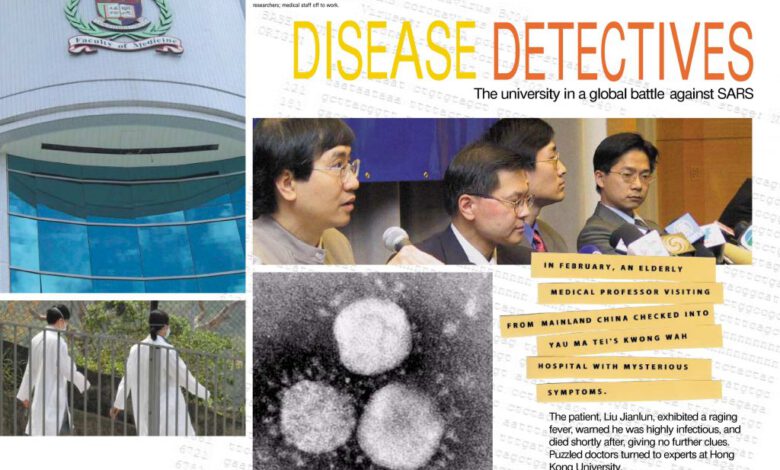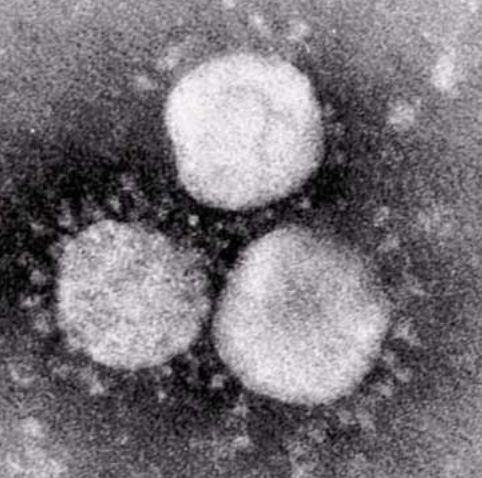Remembering SARS 2003

The University of Hong Kong (HKU) led from the front the fight against SARS virus that swept through China and other parts of Asia in 2002-03, killing at least 813 people. Multiple departments joined forces and students and teachers were roped in.

In addition, more than 200 medical and nursing students from the Medical Faculty kicked off an intensive three-day public education campaign across Hong Kong. The students spent 12-hour days at various MTR stations in a bid to boost public health and confidence in dealing with SARS.
Full story:
– Convocation Newsletter: Disease Detectives – The university in a global battle against SARS
– SARS Special Issue, Medical Faculty News
GENE MAPPING

13 April, 2003. The news of the breakthrough came at a pivotal juncture for Prof Frederick Leung (梁志清), Dean of Faculty of Science, and his team of 10 students at HKU. After spending days and nights in their laboratory, they were close to unraveling the genome sequence for the mystery pneumonia when they heard it.
Canada’s British Columbia Cancer agency had mapped the gene of the Severe Acute Respiratory Syndrome (SARS) virus. By then, the virus that originated in China had infected thousands and killed hundreds the world over. Gene mapping was the first step to containing its spread.
Three days later, the HKU team completed and published their gene mapping. A day earlier, the Centers for Disease Control and Prevention in the US also announced they had mapped the genome. But days later, both the Canadian and US groups had to edit their sequence to match the one developed by the HKU.
FINDING THE CAUSE OF SARS

HKU microbiologists, under the leadership of Professor Malik Peiris (裴偉士), Chief of Virology and Professor Yuen Kwok-yung (袁國勇), Head of Department of Microbiology together with team members including including Guan Yi (管軼), Leo Poon (潘烈文), John Nicolas (黎國思) and Chan Kwok-hung (陳國雄) , successfully identified and cultured the killer virus responsible for the outbreak of SARS. The team also developed an antibody test for the detection of SARS in infected patients.

The microbiology team comprehensively proved the coronavirus is behind SARS and its pioneering work was published in leading international medical journal, The Lancet, on April 19.

Researchers from Guangzhou Medical College, Fudan University and the Department of Microbiology, HKU collaborated on the research of an inactivated coronavirus preparation used for intranasal immunoprophylaxis, with the objective to abort the invasion of live coronavirus into nasal mucosa.
MECHANISM OF SPREADING

Elsewhere in Hong Kong, a team from HKU’s Faculty of Engineering, Engineers Dennis Y C Leung (梁耀彰) and Andy Chan (陳德儀), investigated the mysterious spread of SARS in a Kowloon housing estate, Amoy Gardens. At least 300 residents here were infected and at least 35 died of SARS. Using natural wind flow and living conditions simulations the team managed to trace the cause and contain the spread.
PUBLIC PERCEPTION & PREVENTIVE MEASURES OF SARS

A survey conducted by the Department of Community Medicine team, led by Prof AJ Hedley (賀達理), Prof TH Lam (林大慶) and Dr GM Leung (梁卓偉) in early April revealed anxiety levels and awareness among Hong Kong citizens with regard to SARS. A follow-up survey conducted in mid-April pointed out the SARS epidemic had increased solidarity among Hong Kong people in general, but solidarity within neighborhoods was still weak. The two surveys acted as a rallying call to increase public education about the killer virus in order to help people break the cycle of ignorance and fear.